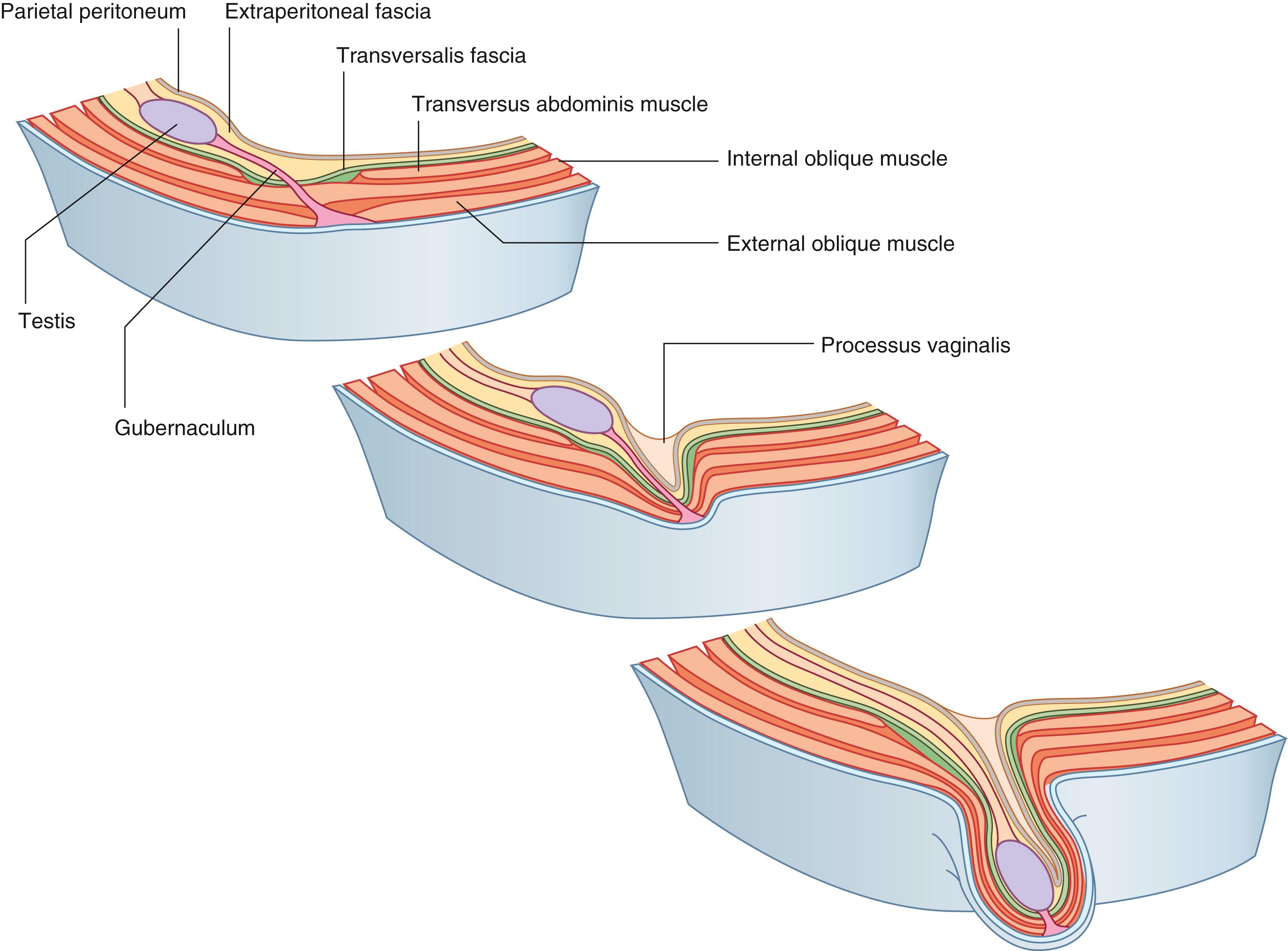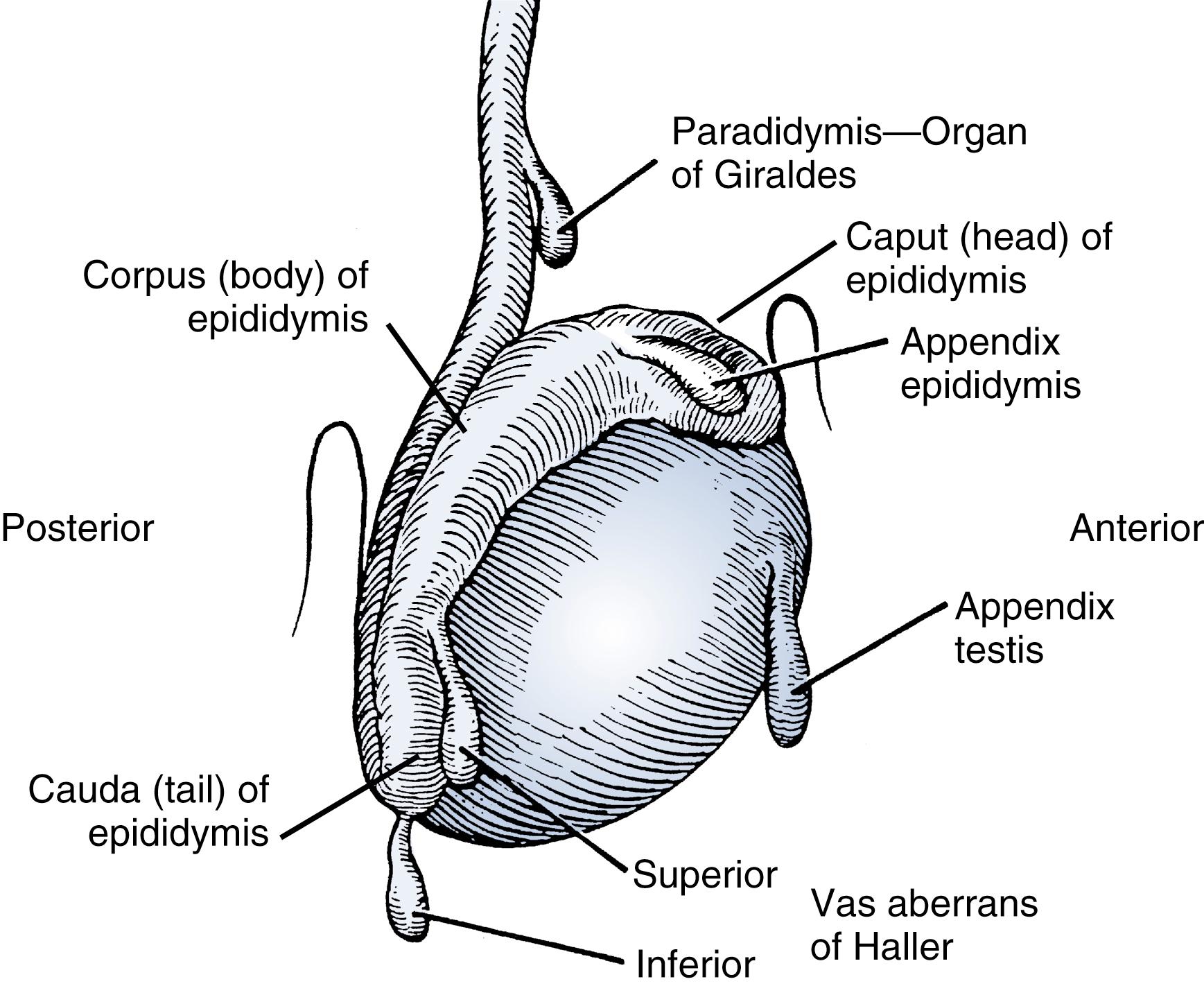Physical Address
304 North Cardinal St.
Dorchester Center, MA 02124
The most serious causes of acute scrotal swelling are testicular torsion and incarcerated inguinal hernia, both of which necessitate immediate surgical correction. Consequently, a prompt, careful approach to a painful or inflamed scrotum is essential. The differential diagnosis of scrotal swelling is extensive and varies depending on the age of the patient ( Tables 24.1 and 24.2 ). The most common causes include testicular torsion, torsion of the appendix testis, and epididymitis.
| Painful | Painless ∗ |
|---|---|
| Testicular torsion Torsion of testicular appendage (less common after adolescence) Epididymoorchitis Trauma: testicular rupture, hematocele Inguinal hernia (incarcerated) Mumps orchitis Vasculitis |
Hydrocele Inguinal hernia (reducible) Varicocele Spermatocele (postpubertal males) Testicular tumor (see Table 24.5 ) ALL Paratesticular tumor Idiopathic scrotal edema Henoch-Schönlein purpura |
The inguinal canal runs obliquely between the external and internal inguinal rings. The anterior wall of the canal is formed by the external oblique aponeurosis; the posterior wall is formed by the inguinal ligament and conjoined tendon. The oblique direction of the inguinal canal allows for the posterior and anterior walls to coapt with increases in intraabdominal pressure.
The testes develop in the lumbar region of the abdominal cavity between the peritoneum and the transversalis fascia at approximately 7 weeks of gestation. By the eighth week of gestation, the gubernaculum extends from the caudal end of the epididymis through the inguinal canal to insert on the internal wall of the scrotum. The processus vaginalis, a finger-like outpouching of the peritoneum, extends adjacent to the gubernaculum to form the inguinal canal. As the processus vaginalis descends into the scrotum, it carries extensions of the abdominal wall layers.
The testis normally descends through the inguinal canal into the scrotum before birth. As the testis and spermatic cord descend through the inguinal canal, they are covered by the three concentric layers of the anterior abdominal fascia ( Fig. 24.1 ). When the testis reaches the scrotum, the testis and surrounding layers of fascia and tunica vaginalis fuse to the dartos of the scrotum. The processus vaginalis is initially patent, leaving a connection between the scrotum and the peritoneal cavity. Normally, the processus vaginalis obliterates, leaving a residual tunica vaginalis surrounding the testis. Typically, the tunica vaginalis contains 1–2 mL of clear fluid.

The scrotum has two separate compartments, each containing a testis, epididymis, and distal spermatic cord. It comprises multiple layers that are continuous with the superficial layers of the anterior abdominal wall. The external location of the scrotum results in the temperature of the testes being 2–3°F below the core body temperature, which allows for normal spermatogenesis.
The testes are the male reproductive organs and are suspended in the tunica vaginalis of the scrotum by the spermatic cords. The epididymis, attached to the testis posteriorly, consists of the caput (upper pole), corpus (body), and cauda (tail) ( Fig. 24.2 ). The vas deferens can be palpated as a narrow, firm, tubular structure in the spermatic cord. The epididymis is responsible for sperm maturation and storage. Each testis relies on three arteries for its blood supply: the testicular artery, the cremasteric artery, and the deferential artery. Each enters the scrotum through the spermatic cord. The testicle receives both sympathetic and parasympathetic innervation. These autonomic nerves carry impulses that, with testicular stimulation, produce symptoms of deep visceral pain and nausea.

In evaluating acute or chronic scrotal swelling, the following historical elements should be established:
Onset of pain : Testicular torsion has a very sudden onset and can be precipitated by activity or can occur at rest or during sleep. Epididymitis or torsion of the appendix testis or other testicular appendage often has a more insidious onset over the course of days, with progressive pain and swelling.
Duration of pain : Episodic pain lasting seconds and abating is rarely pathologic, whereas severe pain, persistent pain, or episodes lasting more than 1 hour raise concern.
Associated/radiation of pain : If there is radiation of pain from the flank, then renal or ureteral pathologic processes, such as an obstructing ureteral calculus, should be considered. Inguinal discomfort may suggest hernia or other inguinal pathology.
Although sometimes nonspecific, associated manifestations are also important:
General systemic : Fever, chills, or rigors suggest an infectious cause.
Abdominal signs/symptoms : Nausea, vomiting, and abdominal or inguinal pain are common but nonspecific. They may indicate an intestinal process.
Urologic signs/symptoms : Dysuria, urinary frequency, hematuria, or penile discharge suggests an infectious process such as urinary tract infection, urethritis, or epididymitis.
Unusual rashes : Henoch-Schönlein purpura may result in vasculitis of the spermatic cord with associated scrotal pain and swelling.
In addition, a thorough medical history is imperative and should include the following:
History of urinary tract infections or renal calculi.
Prior sexual activity, which would raise the possibility of a sexually transmitted infection.
History of any surgical procedures on the groin, scrotum, or abdomen. Often an orchiopexy performed for an undescended testis places the testis in a dartos pouch, which would make testicular torsion unlikely in the future.
History of any previous episodes of testicular pain. Previous episodes of intermittent or severe pain in the same testis may be secondary to intermittent torsion of the testis.
Lower urinary tract pathologic processes, such as posterior urethral valves, neuropathic bladder, or urethral stricture (e.g., after trauma or hypospadias repair), may predispose to urinary tract infection, which could cause bacterial epididymitis.
Examination of the scrotal contents should be performed in any male patient presenting with abdominal, inguinal, or scrotal pain. Essential components include inspection, palpation, and transillumination of any masses.
In prepubertal males, torsion of the appendix testis is more common than testicular torsion ( Table 24.3 ). Conversely, in the postpubertal male, testicular torsion and epididymitis (if the patient is sexually active) are more common.
| Testicular Torsion | Epididymoorchitis | Torsion of the Appendix Testis | |
|---|---|---|---|
| Age | Usually perinatal and 12–18 yr, but any age possible | Usually adolescence, but any age possible | 2–12 yr |
| Symptoms and signs | Abrupt onset; may have previous similar episodes | Gradual onset | Gradual onset |
| Pain | Localized to the testis and may radiate to groin and lower abdomen | Localization to epididymis; may involve entire testis after 24 hr | Localization to upper pole of testis; may involve entire testis after 24 hr |
| Fever | Rare | Common | Rare |
| Vomiting | Common | Rare | Rare |
| Dysuria | Rare | Common | Rare |
| Physical examination | Testis may be high riding, swollen, exquisitely tender; scrotal erythema may be present; cremasteric reflex absent | Testis and epididymis are firm, tender, swollen; scrotal erythema may be present; cremasteric reflex present | Testis is normal or enlarged; firm mass may be seen or felt at upper pole, distinct from epididymis; scrotal erythema may be present; cremasteric reflex present |
| Pyuria, urinary infection | Rare | Possible, particularly in bacterial epididymitis | Rare |
| Blood flow (color Doppler study) | Diminished or absent | Increased | Normal or increased |
Scars may imply previous surgery for hernia, hydrocele, undescended testis, or varicocele.
Erythema suggests an underlying inflammatory process but is nonspecific. Duskiness or fixation of the skin over the testis is suggestive of testicular necrosis.
A testis positioned high in the scrotum is suggestive of testicular torsion. The spermatic cord shortens as it twists. The affected testis should be compared with the contralateral testis with respect to size, consistency, and tenderness. Accurate localization of pain to the testis, epididymis, or both is important.
Stimulated by gently scratching the ipsilateral medial thigh, reflexive cremaster muscle contraction causes the scrotum to retract. The presence of a symmetric cremasteric reflex makes testicular torsion less likely. An absent cremasteric reflex is nonspecific. Sometimes with anxiety, the testis of a child will retract high into the inguinal canal. An important maneuver to relax the cremaster muscle is to examine the patient in a seated position with the legs crossed.
Become a Clinical Tree membership for Full access and enjoy Unlimited articles
If you are a member. Log in here